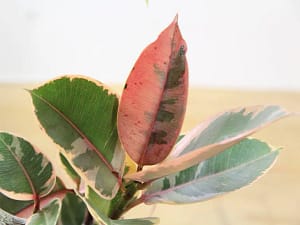About Ficus elastica ‘Belize’
The Ficus elastica ‘Belize’ is a vibrantly variegated cultivar of the incredibly popular and easy-to-grow rubber tree, with stunning red, pink, burgundy, cream and green colours and unique patterns on each new leaf. It goes without saying – this is one of our favourite houseplants that we have at home.
This unique variety adds a splash of colour to any
room and delights with the watercolour-like splotches of variegation that is completely individual to each leaf. Giving the plant a bright, central spot is crucial to bringing out the most vibrant colours as it may lose some lustre in low-light.
While the rubber tree can reach 30 metres in the wild forests of South and Southeast Asia, this cultivar is unlikely to eclipse 3 metres indoors, but will delight you with beautiful new pink leaves if provided with some relatively basic and easy-to-achieve growing conditions.
Rubber plants are popular in homes and offices because they are so easy to care for and require minimal maintenance. The most common problem is overwatering, which is easy to solve, but typically it will be happy in most indoor climates that are comfortable to you.
If you’re looking for your first plant, this is a good option that is long-lived with minimal maintenance and is very rewarding. If this is the plant for you, read our buyer’s guide below to get your plant delivered direct to you.
Ficus elastica ‘Belize’ in the House & Office
Growing the Ficus elastica ‘Belize’ indoors is not difficult, as the plant adapts easily to most indoor climates and requires minimal maintenance.
The large and colourful leaves produce ample amounts of fresh, clean, oxygenated air and are perfect for trapping dust – just give them a wipe at least once each month.
Studies from NASA show that the species is effective in reducing levels of toxic particles in the air, including formaldehyde, although it wasn’t particularly too high on their list of selected plants. While their study wasn’t on this cultivar, the Belize should be roughly as effective.
Ficus elastica ‘Belize’ Size
As this tree can grow to a significant size in the wild, it can still become a very large plant when grown indoors. While it can reach up to 300cm indoors, it often doesn’t reach this size and can be controlled by providing it with less fertiliser and by reducing light.
Height: up to 300cm / 118in / 9.8ft
Spread: up to 180cm / 70in / 5.9ft
Ficus elastica ‘Belize’ Care
Light: This plant will thrive in bright indirect light but dislikes strong, direct light from south-facing windows. As this cultivar is highly variegated, it requires more light than its all-green counterpart, and will lose some lustre if not provided with enough light. Keep your plant within a few feet of most bright windows, but at least five feet from a south-facing window to give it good and bright light that isn’t too strong.
Soil: It can suffer from root-rot if the soil doesn’t drain well enough, so provide a potting soil that contains at least 30% materials that don’t retain water, such as perlite. Make sure that the pot has a drainage hole and that the soil doesn’t remain waterlogged for any period of time.
Watering: Your Ficus elastica ‘Belize’ doesn’t need to be watered often. A once-weekly watering should suffice, but you can determine when to provide more water by feeling if the top one inch of soil is dry – if so, it needs a drink.
Humidity: While these plants can be happy enough with most indoor climates, they do prefer humidity levels over 50%. For optimal growth, provide a humidity level of more than 60% by grouping your plant together with others, turning on a humidifier or by sitting the pot on top of a tray of pebbles and water. Keep your plant in a well-lit bathroom or kitchen where the humidity is highest in the home.
Feeding: Provide a small amount of standardd fertiliser every couple of weeks during the peak of summer, but once per month at other times. Don’t feed during winter as the plant will reduce its growth rate and salts from the feed will build up in the soil.
Temperature: Your plant will thrive in most indoor conditions, so temperatures of 18-24°C / 64-75°F will be ideal. The Belize will be happy at temperatures above and below those levels, if not extreme, but do not allow the plant to reach near freezing temperatures.
Ailments: These plants can be prone to leaf drop, which can happen after transplanting, suddenly changing its environment, or if exposed to strong, direct sun for too long.
Further care: Read our full care guide to help your plant thrive.
Where To Buy Ficus elastica ‘Belize’ Online
- Ebay (UK) / (USA)
- Etsy
- Bloombox Club (UK) / (USA)
- Local Facebook Groups
While the main plant is easy to find, the Ficus elastica ‘Belize’ cultivar is somewhat uncommon. Finding it for sale online should not be too difficult, but you may need to check through a few different plant retailers.
The easiest place to find these available will be Ebay and Etsy, where you can often also choose the exact plant that you would like to purchase.
We would recommend that you buy from a well-rated, positively-reviewed retailer online which can show a respectable return policy.
If you do buy online, you should inspect your plant after receiving the delivery and be sure to not introduce an infected or infested plant to the rest of your plant collection, to prevent any possible spread.
If you are unhappy with the plant you receive in any way, contact the retailer and begin the return and refund process, and never settle for a houseplant that is damaged or otherwise unhealthy.
FAQs
Is Ficus elastica ‘Belize’ rare?
This cultivar is uncommon but not particularly rare by today’s standards. You can find it at some garden centres – we even purchased our own Belize at Pugh’s Garden Village in Wales – and it can be found fairly easily online.
Does the Ficus elastica ‘Belize’ need much sunlight?
Yes, the Belize needs plenty of bright sunlight through the day. It needs more than the standard Ficus elastica because the variegated leaves contain less chlorophyll to create energy with. However, you should not expose it to direct light from a south-facing window, as this could be strong enough to burn the leaves.


